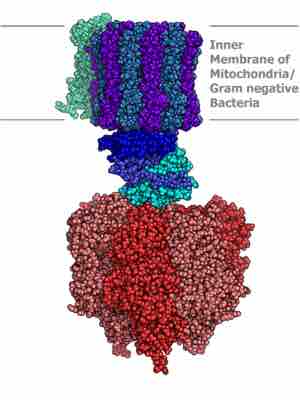ATP synthase is an important enzyme that provides energy for the cell to use through the synthesis of adenosine triphosphate (ATP). ATP is the most commonly used "energy currency" of cells from most organisms. It is formed from adenosine diphosphate (ADP) and inorganic phosphate (Pi), and needs energy.
The overall reaction sequence is: ATP synthase + ADP + Pi → ATP Synthase + ATP
Energy is often released in the form of protium or H+, moving down an electrochemical gradient, such as from the lumen into the stroma of chloroplasts or from the inter-membrane space into the matrix in mitochondria.
Located within the mitochondria, ATP synthase consists of 2 regions: the FO portion is within the membrane and the F1 portion of the ATP synthase is above the membrane, inside the matrix of the mitochondria .

ATP synthase
Molecular model of ATP synthase by X-ray diffraction method
The nomenclature of the enzyme suffers from a long history. The F1 fraction derives its name from the term "Fraction 1" and FO (written as a subscript letter "o", not "zero") derives its name from being the oligomycin binding fraction. Oligomycin, an antibiotic, is able to inhibit the FO unit of ATP synthase.
F1- ATP Synthase structure: The F1 particle is large and can be seen in the transmission electron microscope by negative staining. These are particles of 9 nm diameter that pepper the inner mitochondrial membrane. They were originally called elementary particles and were thought to contain the entire respiratory apparatus of the mitochondrion, but, through a long series of experiments, Ephraim Racker and his colleagues (who first isolated the F1 particle in 1961) were able to show that this particle is correlated with ATPase activity in uncoupled mitochondria and with the ATPase activity in submitochondrial particles created by exposing mitochondria to ultrasound. This ATPase activity was further associated with the creation of ATP by a long series of experiments in many laboratories.
The FO region of ATP synthase is a proton pore that is embedded in the mitochondrial membrane. It consists of three main subunits A, B, and C, and (in humans) six additional subunits, d, e, f, g, F6, and 8 (or A6L).
E. coli ATP synthase is the simplest known form of ATP synthase, with 8 different subunit types.